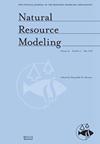基于排队系统的考虑水-能-粮关系的可持续农业供应链网络设计:一个混合鲁棒可能性规划
IF 2.1
4区 环境科学与生态学
Q3 ENVIRONMENTAL SCIENCES
引用次数: 14
摘要
由于农业和食品工业的性质,对其生产、储存、运输、废物处理和环境影响的管理至关重要。为了解决与其供应链相关的可持续性问题,我们在本研究中提出了一个数学模型来设计高度易腐农产品(草莓)的可持续供应链。该模型是一个多周期、多产品的多目标MINLP数学程序,考虑了经济、社会和环境目标,涵盖了可持续性的各个方面。此外,首次开发了G/M/S/M排队系统,用于在设施之间运输收获的产品。由于与食品和农业等行业相关的现实世界问题本质上是不确定的,在该模型中,使用模糊集理论将问题的重要参数视为不确定,并开发了一个混合鲁棒可能性规划模型。此外,Epsilon约束方法将多目标数学模型转换为单目标数学模型,并使用拉格朗日松弛方法在大范围内有效地求解该模型。提供了一个在伊朗的案例研究,以调查结果并讨论解决方案。最后,进行灵敏度分析,以确定重要参数对解决方案的影响。根据分析,为温室配备滴灌系统和在温室中使用太阳能电池板对提高所有目标功能的影响最大。本文章由计算机程序翻译,如有差异,请以英文原文为准。
Sustainable agriculture supply chain network design considering water‐energy‐food nexus using queuing system: A hybrid robust possibilistic programming
Due to the nature of the agricultural and food industry, the management of production, storage, transportation, waste disposal and environmental effects of their production, are of great importance. To deal with the sustainability issues linked to their supply chains, we propose in this study a mathematical model to design a sustainable supply chain of highly perishable agricultural product (strawberry). The model is a multiperiod, multiproduct multiobjective MINLP mathematical program that takes into consideration economic, social and environmental objectives to cover all aspects of sustainability. In addition, a G/M/S/M queuing system is developed for the transportation of harvested products between facilities for the first time. Since real‐world problems related to industries such as food and agriculture are inherently uncertain, in this model, the important parameters of the problem are considered uncertain using fuzzy sets theory and a hybrid robust possibilistic programming model is developed. In addition, the Epsilon constraint approach converts the multiobjective mathematical model into a single‐objective one and the Lagrangian relaxation method is used to effectively solve the model on a large scale. A case study in Iran is provided to investigate the results and discuss the solutions. Finally, a sensitivity analysis is performed to identify the impacts of important parameters on the solution. According to the analysis, equipping greenhouses with drip irrigation system and using solar panels in greenhouses, respectively, have the greatest impact on improving all target functions.
求助全文
通过发布文献求助,成功后即可免费获取论文全文。
去求助
来源期刊

Natural Resource Modeling
环境科学-环境科学
CiteScore
3.50
自引率
6.20%
发文量
28
审稿时长
>36 weeks
期刊介绍:
Natural Resource Modeling is an international journal devoted to mathematical modeling of natural resource systems. It reflects the conceptual and methodological core that is common to model building throughout disciplines including such fields as forestry, fisheries, economics and ecology. This core draws upon the analytical and methodological apparatus of mathematics, statistics, and scientific computing.
 求助内容:
求助内容: 应助结果提醒方式:
应助结果提醒方式:


